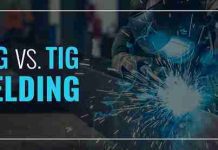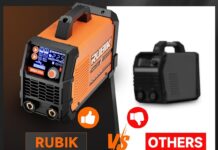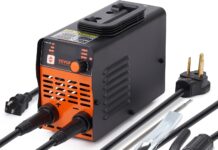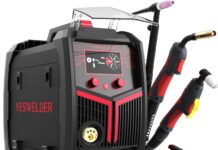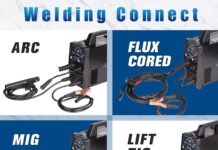Stick welding, also known as Shielded Metal Arc Welding (SMAW), is a popular method used to join metals together. In this process, an electrode (a coated metal rod) is used to create an arc that melts the metal being welded, forming a strong bond. Stick welding is widely favored for its versatility, as it can be performed in various environments and on a wide range of materials, including steel, stainless steel, cast iron, and more. Whether you’re a beginner or an experienced welder, stick welding offers a practical and efficient solution for numerous applications.
I. Introduction
Stick welding, also known as shielded metal arc welding (SMAW), is a versatile and widely used welding process. It involves creating an electric arc between a flux-coated electrode and the workpiece to melt and fuse the metals together. This article will provide a comprehensive overview of stick welding, including its definition, history, use and application, techniques, safety measures, weld defects and troubleshooting, maintenance and cleaning, skill development, and future trends.
II. Definition
A. Overview
Stick welding is a welding process that utilizes an electrode, also known as a “stick” or “rod,” to create an electric arc between the electrode and the workpiece. The electrode is coated with a flux material that vaporizes during welding, producing a shielding gas and a layer of slag, which protects the weld from atmospheric contamination. Stick welding can be used to join various metals, including carbon steel, stainless steel, and cast iron. It is commonly used in industries such as construction, fabrication, and maintenance.
B. Process
The process of stick welding involves several steps. First, the workpiece and the electrode are properly prepared by cleaning off any surface contaminants and, in some cases, beveled to create a V-shaped groove for better weld penetration. Next, the electrode is inserted into the electrode holder, which is connected to the welding machine’s power source. The electric current passes through the electrode, creating an arc between the electrode and the workpiece. As the electrode melts, the flux coating vaporizes, creating a shielding gas and slag. The molten metal from the electrode fills the gap between the workpiece, creating a strong weld.
C. Equipment
To perform stick welding, several pieces of equipment are required. These include a welding machine with a power source, an electrode holder, and a ground clamp. The welding machine supplies the electric current necessary for the welding process, while the electrode holder holds the electrode in place during welding. The ground clamp is connected to the workpiece to complete the electrical circuit. Additionally, personal protective equipment, such as a welding helmet, gloves, and a welding jacket, is essential to ensure safety during welding operations.
III. History
A. Invention
The invention of stick welding can be traced back to the late 19th century when a Russian scientist, Nikolay Benardos, patented the first successful arc welding method in 1881. However, it was not until the early 20th century that stick welding gained significant popularity with the development of coated electrodes. These coated electrodes provided better arc stability, increased weld quality, and improved protection against atmospheric contamination.
B. Development
Over the years, stick welding has undergone various advancements and improvements. The development of new electrode types, such as low hydrogen electrodes, has further enhanced the quality and strength of stick welds. Additionally, improvements in welding machine technology, including the introduction of inverter-based power sources, have made stick welding more efficient and user-friendly. Despite the emergence of other welding processes, stick welding continues to be widely used due to its versatility and cost-effectiveness.
IV. Use and Application
A. Industries
Stick welding finds applications in a wide range of industries. It is commonly used in the construction industry for welding structural steel and reinforcing bars. In the fabrication industry, stick welding is often employed for joining thick metal plates and pipes. Maintenance and repair work also frequently utilize stick welding for its portability and versatility. Other industries, such as shipbuilding, automotive, and agriculture, also rely on stick welding for various welding tasks.
B. Advantages
Stick welding offers several advantages that contribute to its widespread use. One of the significant advantages is its versatility in welding different types of metal, including carbon steel, stainless steel, and cast iron. Stick welding can be performed both indoors and outdoors, making it suitable for a wide range of working environments. Additionally, stick welding equipment is relatively affordable and portable, making it accessible for small-scale operations and remote locations.
C. Limitations
Despite its advantages, stick welding also has limitations to consider. The process produces more spatter compared to other welding methods, which may require additional cleaning after welding. Stick welding is also less suitable for welding thin metals due to the higher heat input and potential for distortion. Furthermore, stick welding is a slower process compared to other welding methods, which may affect productivity in high-volume production scenarios.
V. Techniques
A. Preparation
Proper preparation is essential for successful stick welding. Before starting, the workpiece should be cleaned thoroughly to remove any dirt, grease, or rust that could affect the quality of the weld. Additionally, the edges of the joint may need to be beveled to ensure better fusion and penetration. Proper joint fit-up is also crucial, as it affects the strength and integrity of the weld. Taking time to clean, bevel, and fit the joint accurately will help produce high-quality stick welds.
B. Electrode Selection
Choosing the right electrode is vital for achieving desired welding results. Electrodes vary in composition, coating, and diameter, and each type is suited for specific applications. For example, a low hydrogen electrode is suitable for welding high-strength steel and avoiding hydrogen-induced cracking. Conversely, cellulose electrodes are commonly used for welding pipelines due to their deep penetrating properties. The proper electrode selection depends on factors such as the base metal, joint configuration, and desired weld quality.
C. Welding Process
The stick welding process involves specific techniques to ensure optimal weld quality. Maintaining a proper arc length between the electrode and the workpiece is crucial. Too long of an arc length can cause incomplete fusion, while too short of an arc length can result in excessive spatter and poor penetration. The travel speed, or the speed at which the welder moves along the joint, also affects the weld quality. A consistent travel speed helps control the amount of heat input and ensures even fusion. Lastly, proper electrode manipulation techniques, such as weaving or oscillating motion, can distribute the weld metal evenly and prevent defects.
VI. Safety Measures
A. Protective Gear
When engaging in stick welding, it is essential to prioritize safety. The welder should wear appropriate protective gear, including a welding helmet with a dark lens to shield the eyes from the intense UV radiation. Welding gloves, preferably made of leather, protect the hands from sparks and heat. A welding jacket made of flame-resistant material is necessary to guard the body against splatter and potential burns. Additional protective gear, such as earplugs, steel-toed boots, and respirators, may be required depending on the specific welding environment.
B. Ventilation
Proper ventilation is crucial during stick welding to ensure the removal of hazardous fumes and gases. Welding produces toxic fumes, such as ozone, nitrogen dioxide, and metal vapors, which can be harmful when inhaled. Adequate ventilation systems, such as local exhaust ventilation or forced air systems, should be in place to maintain a safe working environment. If welding indoors, it is crucial to ensure that the area is well-ventilated or use additional ventilation equipment to minimize exposure to harmful fumes.
C. Electrical Safety
Stick welding involves working with electricity, making electrical safety measures essential. Welding machines should be properly grounded to prevent electric shocks. The welder should also inspect all cables and connections regularly to ensure they are in good condition. Additionally, it is important to use the correct input power voltage to avoid damaging the welding equipment. Following electrical safety guidelines and using the appropriate safety precautions minimizes the risk of electrical accidents during stick welding.
VII. Weld Defects and Troubleshooting
A. Common Defects
Stick welding, like any other welding process, can result in various weld defects. Some common defects include lack of fusion, porosity, slag inclusion, and weld cracks. Lack of fusion occurs when the weld metal doesn’t fuse properly with the base metal, resulting in a weak joint. Porosity refers to the presence of gas pockets within the weld, which can weaken the weld strength. Slag inclusion occurs when the slag is trapped in the weld, affecting its quality. Weld cracks can occur due to thermal stresses or inadequate joint preparation.
B. Causes
Understanding the causes of weld defects is crucial for troubleshooting and preventing future issues. Lack of fusion can occur due to incorrect welding techniques, incorrect electrode angle, or improper joint fit-up. Porosity can be caused by inadequate shielding gas, contaminants on the surface, or excessive arc length. Slag inclusion can happen when the welder doesn’t properly remove the slag between weld passes or when the weld pool isn’t properly protected. Weld cracks can be caused by factors such as high heat input, inadequate preheating, or improper joint preparation.
C. Solutions
Addressing weld defects requires identifying the root causes and implementing appropriate solutions. For lack of fusion, adjusting welding techniques, improving joint fit-up, or using a different electrode type may be necessary. Porosity can be minimized by ensuring proper shielding gas coverage, conducting thorough surface cleaning, and maintaining a suitable arc length. Slag inclusion can be prevented by properly removing slag between weld passes and using suitable welding techniques. Weld cracks can be avoided by controlling heat input, implementing proper preheating, and ensuring accurate joint preparation.
VIII. Maintenance and Cleaning
A. Cleaning
Proper maintenance and cleaning are essential to extend the lifespan of stick welding equipment. After each welding session, it is important to remove any slag, spatter, or debris from the electrode holder and the welding machine. The electrode holder should be inspected regularly for wear or damage and cleaned to ensure proper electrical contact. Additionally, the welding cables and connections should be cleaned and checked for any signs of damage. Routine cleaning helps maintain equipment performance and reduces the risk of malfunctions during welding operations.
B. Storage
Proper storage of stick welding equipment is crucial to prevent damage and ensure its longevity. Electrodes should be stored in a dry and temperature-controlled environment to prevent moisture absorption, which can affect their quality and performance. The welding machine should be stored in a clean and dry area, protected from dust, humidity, and extreme temperatures. Proper storage not only preserves the integrity of the equipment but also minimizes the need for repairs or replacements.
C. Maintenance
Regular maintenance of stick welding equipment is necessary to keep it in optimal working condition. This involves inspecting the welding machine for any signs of wear or damage, such as frayed cables or loose connections. Any identified issues should be promptly addressed or repaired by a qualified technician. Routine maintenance also includes lubricating moving parts, checking power sources, and calibrating welding machines as necessary. By investing in regular maintenance, the lifespan of stick welding equipment can be significantly extended.
IX. Skill Development
A. Training
Developing the necessary skills for successful stick welding requires proper training and practice. Training programs, such as vocational courses or apprenticeships, provide theoretical knowledge and practical hands-on experience. These programs cover topics such as welding techniques, electrode selection, joint preparation, and safety measures. Attending training programs helps individuals gain a solid foundation in stick welding and prepares them for real-world welding applications.
B. Certification
Obtaining certification in stick welding is valuable for demonstrating proficiency and credibility as a welder. Certification programs, offered by organizations such as the American Welding Society (AWS), assess the welder’s skills and knowledge through standardized tests. Achieving certification requires successfully completing both written and practical examinations. Welders who obtain certification can showcase their expertise and enhance their employability in various industries that require stick welding.
X. Future Trends
A. Technology Innovations
The field of stick welding continues to evolve with technological advancements. One notable innovation is the development of new electrode coatings that offer improved welding characteristics and reduced spatter. Inverter-based welding machines, which are smaller, lighter, and more energy-efficient, have also become more prevalent in stick welding. Additionally, advancements in control systems and automation technology are expected to enhance the precision and efficiency of stick welding processes in the future.
B. Automation
Automation is an emerging trend in the welding industry, including stick welding. Robotic systems and automated welding cells are increasingly used to perform repetitive or specialized welding tasks. Automation offers benefits such as increased productivity, improved weld quality, and enhanced worker safety. Furthermore, emerging technologies, such as machine learning and artificial intelligence, have the potential to further optimize and automate stick welding processes.
In conclusion, stick welding is a versatile and widely used welding process that has a rich history of development and application across various industries. Its ability to join various metals and its accessibility make it a popular choice for welding needs. By understanding the techniques, adhering to safety measures, and addressing weld defects appropriately, professionals can ensure the successful execution of stick welding projects. As technology advances, the future of stick welding holds promising possibilities for enhanced productivity and automation.



